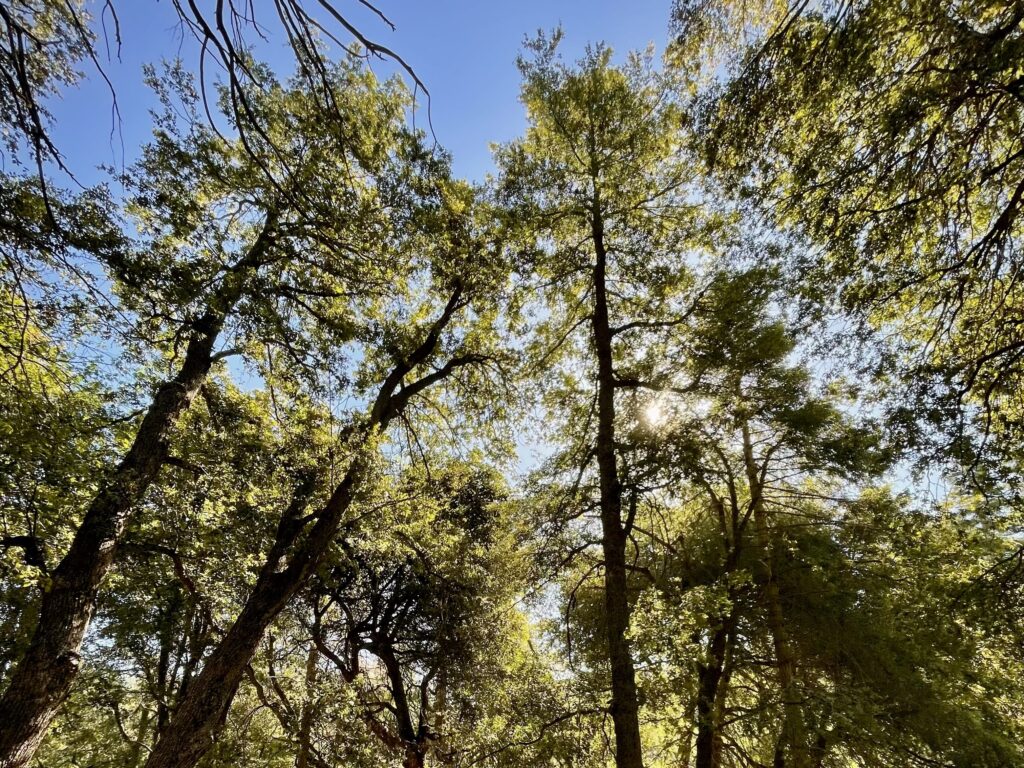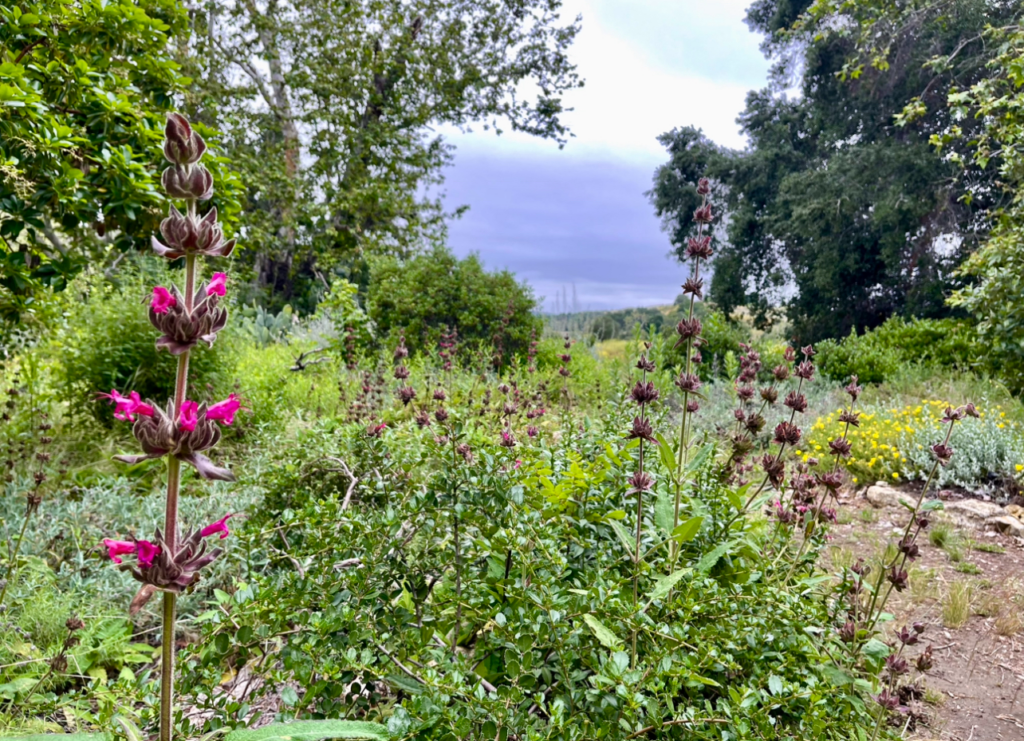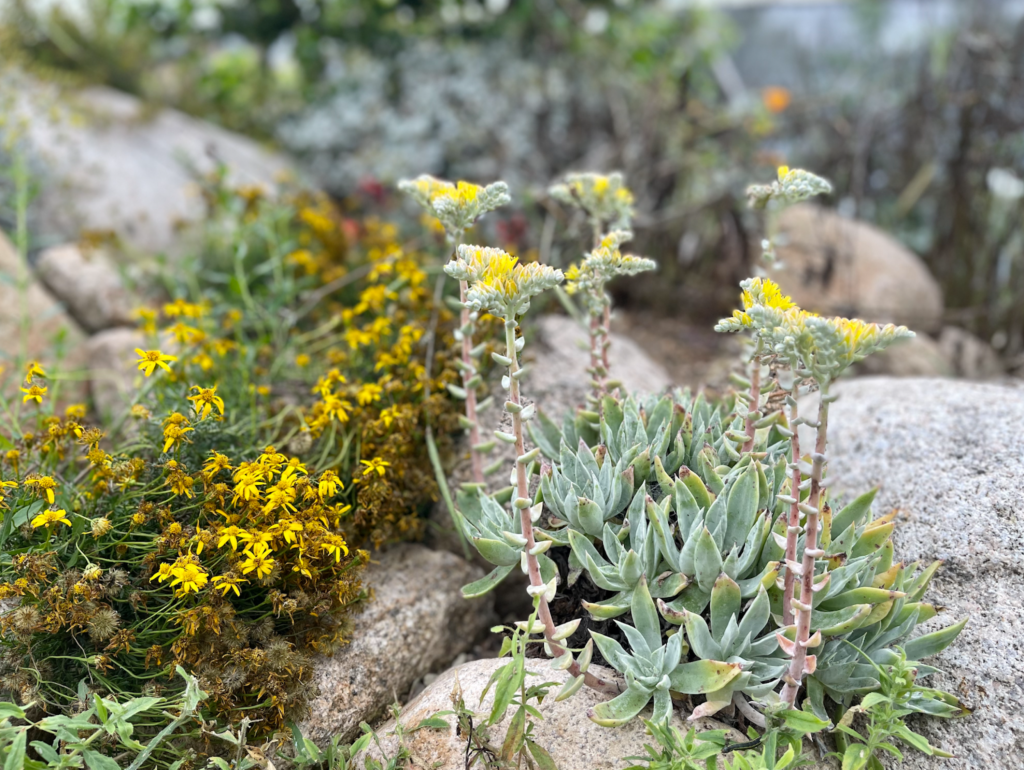June in the Natural Garden
- Posted in: Blog, Monthly Garden Advice
- Tags Garden Maintenance, Seasonal Gardening, Words by Mike Evans

We’re looking forward to summer with warmer temps, but in reality, near the coast we’re still wearing long sleeves and even a jacket now and then. Throughout the month of May our weather has been cool, our skies gray, and our plants soft and lush, still intoxicated on the abundant moisture they received last winter. When the marine layer burns off (and it will), our garden plants will be confused and bewildered, unless we perform a few easy tasks to help them get ready.

Current events, history, review, and notes
The Pre-Summer month of “May Gray” and the so-called “June Gloom” are weather phenomena typical of our Mediterranean climate. Since ocean temperatures are still cool, and the interior land is starting to heat up, we get this wonderful inversion layer as the inland region “pulls” moist air in off the sea. We experience cool breezes, cloudy nights and mornings, occasional drizzle, and some days when the clouds are so thick they never burn off.
Watering
For the most part, plants are as verdant (green) and turgid (lush) as they can be. Last season’s 25” of rain, delivered evenly over a 6-month period, did that. Here are the factors that determine how often you provide a Deep Soak as part of this summer’s watering regime:
Your location – coast is cool, inland is warm
Your plants – the theme of your garden, its narrative, the types of plants you have
Exposure – sun, shade, mixture
Slope – flat ground is easier to irrigate, holds water longer
Your soils – sand, loam, clay, mixtures
The root depth of your plants – trees and shrubs are deep, soft subshrubs are shallower
The percentage of bare soil – water loss through evaporation only
Your top dress material – “mulch” (organic or mineral) preserves soil moisture
Your garden’s age – mature plants can be watered less frequently than new young plants
The “look” you want – summer stress may appear natural, but will your neighbors approve?
The weather behind – are the plants stressed from a recent heat event?
The weather ahead – coast is temperate all summer, inland will get extremely hot by August
When you combine all those factors, unless you want to test the endurance of your plants for another month, or you live right near the beach, you may want to perform your first Deep Soak sometime this month. The ideal time to water native plants is during periods of cool gray weather.

In a Deep Soak, you put on enough water to simulate 1-1.5” of rainfall. This usually means you have run a typical stream-rotor sprinkler system a long time…like 2 hours or more! Seemingly impossible and impractical, so you do it over a 2-3 day period. Water 3 days in a row, 20-40 minutes per day, in the early mornings. All the water will penetrate deep into the root zone. You will not need to do this again for 4-6 weeks, depending on all the factors listed above. Typically, a natural garden will thrive on 3 to 5 Deep Soaks per year, providing between 3 and 10 inches of water supplemental to our natural precipitation .
Note: Because we got so much rain last season, and May has been so cool, you may want to postpone your first Deep Soak, opting this month to hand water or set a hose-end sprinkler on only the driest section of your garden.
Related to Watering
A Refreshing Sprinkle is when you basically “hose down” your garden with a pistol sprayer, wetting only the leaves and soil surface. In late summer, we do these Refreshing Sprinkles only in the late afternoon / early evening. Though they are not necessary to relieve stress after long hot days this month, an occasional Refreshing Sprinkle in June (anytime of day if it is overcast) will prolong moisture in the plant since plants can take up some water through their leaves. This will not be a substitute for a Deep soak, but it may delay the need for your first Deep Soak until July, especially near the coast, and depending on the weather we get in June.

Pruning
Perhaps this is the most important section of our June letter.
Our friends at www.studio-petrichor.com called it “June Groom” in their May 26 newsletter. Nice one, Shawn Maestretti. #wishidathoughtathat because it’s perfect. Here’s how they put it:
“June is the perfect time to prune about 15-20% of the abundant new growth that has resulted from the recent rainy season. We named this seasonal practice June Groom to apply within the June Gloom window of cool weather. This is the perfect weather to prune back the growth before the heat waves of July through October that put our gardens to the test.
With this practice of reducing some of the garden’s growth, we recommend chopping and dropping the prunings into the garden to add to your soil-building, water-absorbing mulch. Some of you may not love how this looks, while some of you may instead appreciate all that this represents. If you wish to hide this free mulch, tuck it under some of the existing plants. After all, plants were meant to make their own food. We are supporting them in the action they take without even trying.”

Weeding
With warm soils and more sun we will see summer weeds sprouting, just as we are finished with the winter weeds! Always. Pull. Weeds. Always.
Mulching / Top Dress
If you feel you need a layer of imported top dress, be sure to look at last month’s newsletter first. Many people don’t quite get it right on mulching. It is critical that we do not bring harmful material onto the surface of our precious garden soil.
Feeding
Since the cool weather seems to be lingering, you can apply your pre-summer organic fertilizer if you did not do so last month. Do it right away if you’re going to do it. Summer is not the time to feed natives.
Troubleshooting – Varmints, Pests and Diseases
Why are some of my manzanita leaves distorted with bright red bubbles, especially on the new growth? Glad you asked. That is manzanita leaf gall aphid, a tiny insect with a sucking mouthpart, who, unlike most aphids, can create a safe haven for itself and its kin by causing the leaf to wrap around so they are like the fixings inside a tightly sealed taco. It is a natural pest on manzanita and some years are worse than others.

The only safe and effective organic treatment is to remove the damaged leaves as soon as you see the damage. Pull off individual leaves, or prune infested branches, and discard the trimmings in the trash.

Remove the damaged leaves by hand

A dissected gall shows the aphids safe inside

Close up on a gall
This is also the season to start looking for the tell-tale signs of other insect problems on your plants, especially woody shrubs: Argentine ants. While the ants do not per se harm the plant, they are pointing to the problem; scale, mealybug, aphid, and other pests with sucking mouthparts who excrete a sweet liquid called honeydew… which the ants feed on. If you see ants moving up and down your stems, look for the insects they are tending. Organic treatment starts with blasting the bad guys off with water if possible, then moving to insecticidal soaps, or horticultural oils to kill them.
Annual Wildflowers
Assuming you planted seed last fall, you have enjoyed one of the best personal super blooms imaginable. Now you can collect all or part of the seed, separated by species or in a mixed bag, and sort of crumple up the dying plants to add to your mulch layer, thus leaving seed behind for next year. If you did not sow seed last fall (and you are envious of those who did), put it on your calendar for this fall.

Adding New Plants
Because you have become such an expert at routinely caring for (especially the watering aspect) your entire established garden, while focusing more intense care on your newly planted plants, you can have success with new plants almost all year. Just don’t let their root balls dry out, and through hand watering, coax those roots into the soil outside the planting hole. We have a full inventory of natives, with several types available for the first time, or for the first time in a long time. Come on over. We’ll help you with your summer plantings.

Phytophilia
Today I heard my garden say, “If you think last winter was great, wait till you see this summer!”
Important Review
May Gray, June Gloom
Method: Deep Soak with Refreshing Sprinkles, revisited
June Groom
Last call for imported mulch
Last call for fertilizer
Aphids and their friends are not our friends
Flowers setting seeds
New plants need TLC
Plants: It’s gonna be a great summer!
Engage
I think that my favorite part about a life with plants is that it makes us ever hopeful. I also believe that there is no despair in gardening.
When a gopher ravaged our front-yard personal super bloom last month, and my wife wondered if the gopher or I were actually inflicting the most damage (you have to dig holes to set traps), I set my hope on catching the little devil, and it turned into a game. The gopher got more than a few of our plants for a little over a week. I checked the soil surface every morning (sometimes still in pajamas) for fresh dirt from gopher diggings, repeatedly discouraged, religiously resetting the traps. A fair bit of cursing, but ever hopeful for several days.
Finally, on a particular morning there showed zero activity (no fresh mounds) the night before, and one more morning after that. Got it! Game over (especially for the gopher).
Now the soil had been perfectly “tilled” by both the gopher and me and Hilda is still putting some new plants in all the spaces. Some lucky crow or raven found the gopher carcass I left for it so everyone (except the gopher) got a “win-win” out of this. But hey, wrong place at the wrong time I guess, sorry about that.
I think gardening might cause momentary discouragement now and then, but our hope is always much greater, and we never despair. We concentrate on the task at hand. This is in fact one of the healing aspects of working with nature in our natural gardens. Mindfulness, diligence, and passion. We never lose hope. Faith, hope and love, these three, and the greatest of these is love.
Hey, we’re still making it! Let’s keep makin’ it!
From the JUNE in the Natural Garden,
Mike Evans
Questions? Help is just one call or one email away. Call (949) 728-0685 or email (with pictures if you like) our special helpline: gardenhelp@californianativeplants.com
